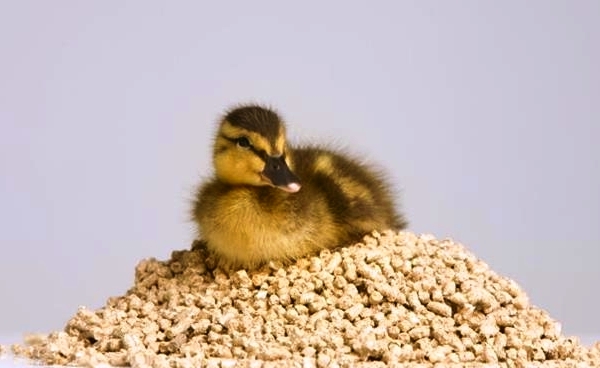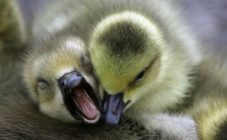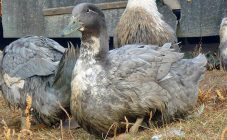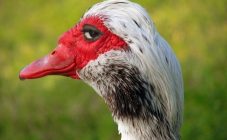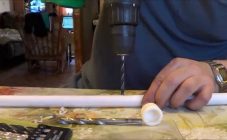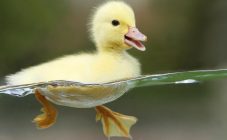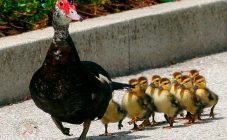Content:
It is profitable to breed ducks as poultry, since the diet can be selected very diverse from the ingredients that are available. They are suitable not only cereals, but also vegetable crops, as well as animal feed.
It is possible and necessary to make food for ducks with your own hands, because only in this case the breeder will be sure of its rich composition, suitable for growing birds of meat and egg breeds. Much depends on whether there is a possibility of grazing near a natural reservoir. There, ducks themselves find insects, small fish, as well as useful herbs and other vegetation. If this is not possible, all that is missing will have to be introduced into the diet artificially.
Optimal Duck Diet
The principles of building a menu of homemade ducks are as follows.
Grain feed
Among all types of cereals for ducks, wheat and corn are best suited. The benefit of using such a basis is unconditional, since the digestive tract of birds is designed in such a way that it will digest this feed almost without residue (about 80%).
It is recommended to fill with cereals up to half of the daily feed rate. Oats are added to increase satiety. You can get the right amount of fiber using millet, it should be added in an amount of 20% of the daily requirement.
Oilcakes
If there is an oil mill or sugar factory nearby, it will not be difficult to acquire waste from their production. It is a cheap but highly beneficial nutritional supplement. Cakes of sunflower, rapeseed, soybeans, peanuts, as well as beets are added little by little at any time of the year. Bran is an equally valuable category of ingredients.
However, both components cannot exceed 20% of the total feed intake. They contain too much fiber, the excess of which is bad for the digestion of birds.
Vegetables, herbs and root vegetables
Juicy shredded vegetables are very popular with ducks. They can be added to feeders at any time of the year. But usually vegetables are added to food in the warm season, since they are much more expensive in winter.
Animal feed
Swimming in ponds and rivers, ducks catch a wide variety of insects, so protein is present in their menu in sufficient quantities. Artificial feed is enriched with additives such as fish or bone meal, pork fat. They are introduced in an amount of up to 7% of the total amount of feed. Fermented milk supplements are also very valuable. There are not so many animal feeds, but they can never be completely ruled out.
Based on the criteria listed above, the composition of the compound feed for ducks is formulated at different times of the year. The ideal solution is at the intersection of two principles: feed should be nutritious and varied, but not too expensive.
Compound feed for ducks: basic rules
Experienced poultry farmers recommend forming a duck diet based on the following conditions:
- To improve egg production, it is necessary to add finely chopped greens to the feeders. It contains a lot of vitamins E and B, indispensable for laying, including for subsequent incubation. You should not be too zealous either, since the basis of a full-fledged diet at any time of the year is cereals.
- When birds are raised for meat, their menu is highly age dependent. The first period is the intensive growth of chicks. At this time, the share of animal feed can account for up to a third. But before slaughter, the bird is fed so that its fat mass increases. Here dairy products come to the rescue, as well as legumes and ground oats.
- It is not necessary to grind the grain too finely. The sticky mass can clog the beaks, or even get stuck in the throat. The food should be moist, but coarse enough to push well up the esophagus. Cooking porridge is an outdated practice that has proven itself poorly. When cooked, cereals take water into themselves, while losing calorie content per unit volume. As a result, the bird eats the same amount, but receives fewer calories.
- You can also give dry feed. In this case, there should always be a drinker at the feeding site. Today, some farmers specifically purchase granulators - equipment that allows you to form special granules from dry feed. Duck drink a lot with such a diet. The method of soaking dry food with water is no worse, but at the same time birds drink less. Vegetable supplements and grass with such feeding should be placed side by side in a separate container.
Features of nutrition, rules for feeding muscovy ducks
Musk or Indo-girls are distinguished by their unsurpassed omnivorousness. It is very difficult to make a mistake with their feeding, because the bird is ready to eat everything that the owner has introduced into the duck mash. For a healthy diet, you need to form a diet mainly from wet mixtures, which include cereals, as well as juicy vegetable and meat additives.
Favorite Indoor Products:
- grass;
- finely chopped beet tops;
- compound feed from several types of cereals (necessarily soaked in water);
- kitchen waste (cooked meat waste, boiled potatoes);
- ground corn.
The pond is not very necessary for musky ducks. If there is - this is good, because then the herd will be able to get a considerable part of their diet on their own. Insects and even worms are caught with both drakes and chicks very deftly. If there is a natural or artificial reservoir with a variety of animals next to the poultry house, then the cost of feeding can be saved very seriously.
What compound feed to feed ducklings
The peculiarity of feeding ducklings is that up to 2 months their growth is very rapid, and for this they need a special diet rich in protein and vitamins. A balanced composition of feed for the growth of ducklings is of decisive importance.
1-10 days
Strong and healthy ducklings can feed on their own. But sometimes you have to feed the weakest ones on the first day through a pipette. This is done only in small farms. With a large livestock, there is simply not enough time and energy to do this.
10-30 days
10 days after hatching, they give a start to the usual diet and feed for the ducklings begins to be served in special feeders, but in no case together with adult birds.
Fish or bone meal is introduced into the menu, which should account for about 7% of the portion. The rest is made up of ground cereals and oilcakes (up to 20%).
If the diet at this time is selected correctly, then with the naked eye changes in the appearance of the ducklings will be noticeable every day. Likewise, their weight changes noticeably.
After 30 days
Already at the age of 1 month, ducklings eat the same way as adult birds. If there is a free range nearby, where you can catch insects or fry in the reservoir, then you can no longer add animal additives to the feed. But not for beef breeds, which require much more protein throughout their lives than others. The optimal feeding regimen is 2-3 times a day at regular intervals.
Starter compound feed for ducklings at 1 month looks as follows:
- 50% - corn;
- 20% - sunflower cake;
- 15% - wheat;
- 3% - feed fat;
- 12% fishmeal.
It is obvious that the optimal diet for ducks is a rather flexible concept, each breeder has a very large room for maneuver. And one of the main rules sounds like this: the more often you change the composition of feed, the better. Knowing how to make a mash for ducklings and adult birds, any farmer can raise a full-fledged livestock.


